 The band Fun appeared on Saturday Night Live on Nov 3rd, 2012, performing their songs, Some Nights and Carry On. Fun’s lead singer, Nate Ruess, was using a stylish gold-plated wireless microphone that was different form the Shure SM58 mics the rest of the band were using. It turns out that Nate’s mic was also a Shure – it was a Shure UR24D/SM58 microphone.
The band Fun appeared on Saturday Night Live on Nov 3rd, 2012, performing their songs, Some Nights and Carry On. Fun’s lead singer, Nate Ruess, was using a stylish gold-plated wireless microphone that was different form the Shure SM58 mics the rest of the band were using. It turns out that Nate’s mic was also a Shure – it was a Shure UR24D/SM58 microphone.
I’m not certain where you can get a gold-plated one like Nate’s, but I’m guessing that if you can afford the Shure UR24D at about $2,300 ($4,659 for a pair), it would be nothing to pay extra for a gold-plated one.

If you are in the market for a high-end wireless hand-held microphone, you can get a pair of Shure UR24Ds like Nate’s by clicking here, though you’ll have to settle for the standard black color, unless you have a friend at Shure who can get it plated in gold for you;). And if you don’t quite have that in your budget, you can be like the rest of the band and pick up a Shure SM58 for a small fraction of the price of Nate’s gold one (literally!) for about $98 by clicking here.
microphones
Microphone in Episode of NBC's Grimm
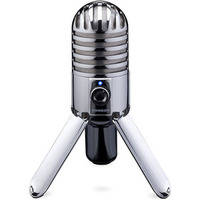
It takes a real audio geek to immediately zero in on a microphone in a TV episode during a shot where a guy is being tortured. But not surprisingly, that is exactly what I did. During the Nov 2nd episode of the TV show Grimm, on NBC, there was a scene of a computer with footage of a guy being tortured with a hot branding iron. Next to the computer, as big as life, was a rather distinctive looking microphone called the Samson Meteor Mic, a USB studio microphone.
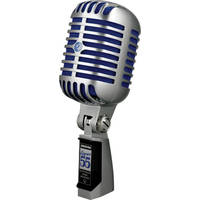
It’s a very distinctive and stylish little mic that is reminiscent of the classic Shure Super-55 “Elvis” type microphone. The Samson Meteor Mic is a compact mic with a folding tripod stand built into it, along with a headphone jacke (1/8th inch) and volume control. Of course being a USB mic, all you have to do is plug it into a computer and start using it. All of those features make it extremely handy and easy to use, as well as being very portable. It costs $55 and is an excellent upgrade from a standard computer mic that you would plug into the sound card of your machine.
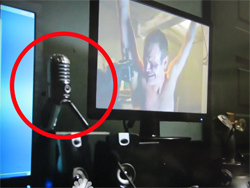
The only complaint I’ve seen about these microphones is that there are no rubber tips on the ends of the tripod legs. The reason that is such a big deal is that it makes it easy for vibrations to travel up from the surface the mic is standing on, such as your desk or whatever table the computer happens to be sitting on. This is pretty easily remedied, however. All you have to do to dampen those vibrations is set the mic on something that will absorb the noise, such as a mouse pad or something else made of rubber.
To find out more, or to get one of these little guys for yourself, click here.
Kansas "Carry On Wayward Son" Harmony: Step-By-Step
Okay, so here is how I recorded the introduction to Kansas’ “Carry on Wayward Son” with just me, myself and I (meaning it was just my voice singing all the parts).
First, take a listen to how it came out:
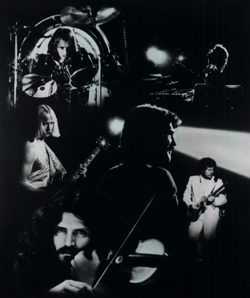 1. I opened my audio recording software, Reaper (see my post on Reaper here) on my computer.
1. I opened my audio recording software, Reaper (see my post on Reaper here) on my computer.
2. I hit the “Record” button in Reaper and sang the melody (the high part:)) into the microphone, which was a Rode NT2-A. The mic was connected to the computer via an audio interface box like the Focusrite Scarlett 2i2.
3. When I finished singing that high part, I inserted another track in Reaper (ctrl-T) and sang that part again, giving me two tracks of my voice singing the same thing.
4. I inserted a 3rd & 4th track and repeated steps 1-2, but singing the middle vocal harmony part.
5. I inserted a 5th and 6th track and repeated steps 1-2, but singing the low vocal harmony part, “low” being extremely relative in this case;).
6. I edited each of the 6 tracks with my audio editing software, called Adobe Audition. Editing consisted of getting rid of “p-pops” and various other mouth-y noises, as well as making sure none of the notes were off-pitch.
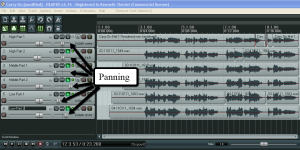
7. Back in Reaper, I panned each track to a specific place in the “stereo spectrum,” which is a fancy way of saying “somewhere between your left ear and your right ear.” both high parts were in the center (right in front of you, between your eyes (actually they were 5% left and 5% right, but they’ll sound like they’re coming from right in front of you). The two middle parts were panned 100% left (“hard left”) and 100% right (yup, “hard right”) respectively. If listened to by themselves it would sound like one was coming from your left and the other coming from your right. The low parts were panned 53% left and right, respectively. These would sound like they were between the guy singing the high part and the guy singing the middle part, kinda like 6 guys were spread out in front of you on a stage. See the figure 1.
8. The next step was to make sure each part was the right volume, not too loud and not to quiet. That’s called mixing, and you do it by adjusting the volume slider on each track so all the sounds work and play well together.
9. Next I added a reverb effect to the “master” channel.
10. I rendered (called “mixing down” in the old days) the project audio down to one stereo file, which I saved as an mp3, and voila.
Look for lots of other home recording tips in the many articles posted here at Home Brew Audio. We’ve also got video tutorials and the eBook How To Build A Home Recording Studio.
Ta for now!
Ken
Microphone Directional Response
This is an excerpt from a course on the excellent Lynda training site. It’s about microphone directional response. I wrote and article about this here – Directional and Omnidirectional Microphones – What Are They Good For? . This video (below) is a great additional piece to help you better understand the same topic. Understanding how a microphone pics up sound is pretty important in both recording and live sound. You can achieve a lot of cool stuff, like lowered noise (with a cardioid’s “null” pointing to the noise source), by knowing the polar pattern of your microphones.
Check out the video on microphone directional response below:
Microphone Barbra Streisand Used In Evergreen Scene AKG C-12A
We just saw a clip, on CBS Sunday Morning, of Barbra Streisand singing Evergreen in the 1976 movie A Star Is Born. She is singing into a vintage AKG C-12A (not to be confused with the C12 or C12 VR). These are not manufactured anymore, but I checked eBay and you can get one for the bargain price of $3,899 (my wife said “no”).
Anyway, the whole reason for this post is that the way this mic – a large diaphragm “nuvistor” (a kind of mini-tube that sort of bridged the gap between tube mics and transistor mics) mic – is used in the supposed recording scene between Streisand and Kris Kristofferson. First it shows Barbra singing straight into the mic, lips 3-4 inches away, with no sort of pop filter at all. I understand that it would have obscured her face and all, but for folks who record vocals every day this just causes us to scream – “Holy crap, do you realize how many plosives (p-pops) that would cause and how hard it would be to edit out, especially in 1976?” (see our article on p-pops and plosives here: https://www.homebrewaudio.com/how-to-fix-a-p-pop-in-your-audio-with-sound-editing-software/). Then she put her hand on the base of the mic where it attached to the mic stand. Gah! That would cause boom and rumble! And THEN, Kristofferson puts HIS mitts on the stand and plays “handsies” with her – in the middle of recording! I imagine that recording engineers the world over utters simultaneous and similar protestations when the movie opened.
In real life, a singer using any large diaphragm recording microphone would surely be using a pop-filter, a screen between the mouth and the mic to reduce or eliminate plosives. And if anything (like fondling fingers) touched or bumped the mic or mic stand, the recording would almost certainly have to be stopped because it would be nearly impossible (certainly impractical) to edit out that kind of rumble, boom and bumping.
But other than that…
There are some interesting facts about the AKG C-12A. It was the missing link mic between the tube-based C12 and the transistor-based AKG C 414. It used a new (at the time) miniature tube technology called “nuvistor” which, if the transistor had not become the way of the future for microphone circuitry. Read more about that here: http://www.preservationsound.com/?p=1120